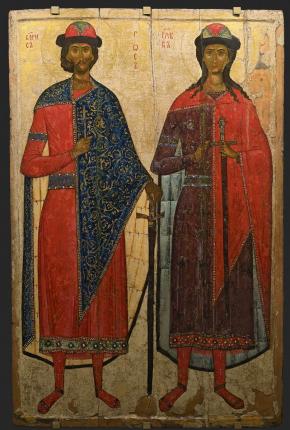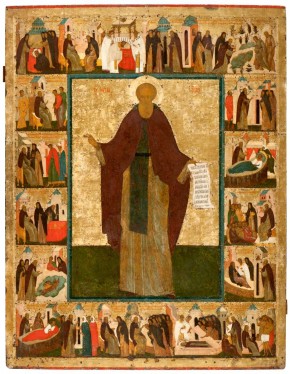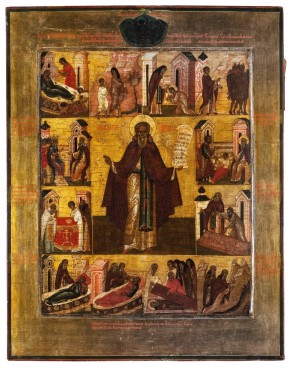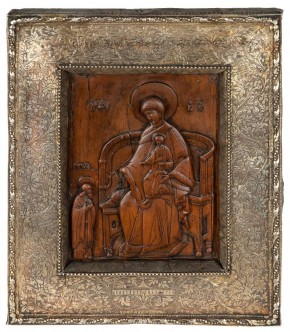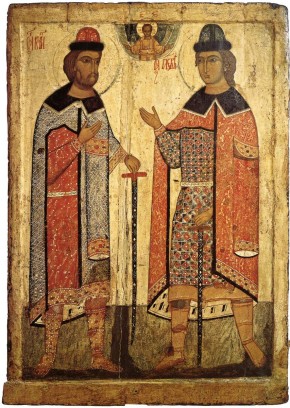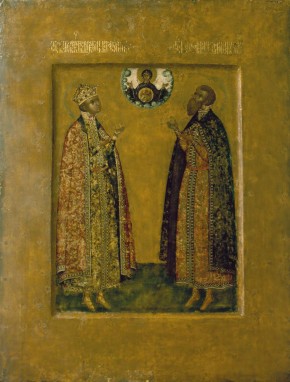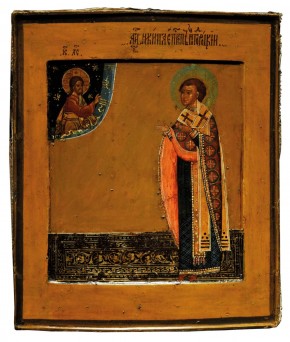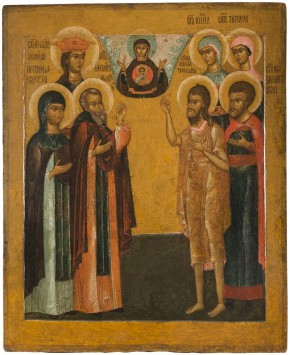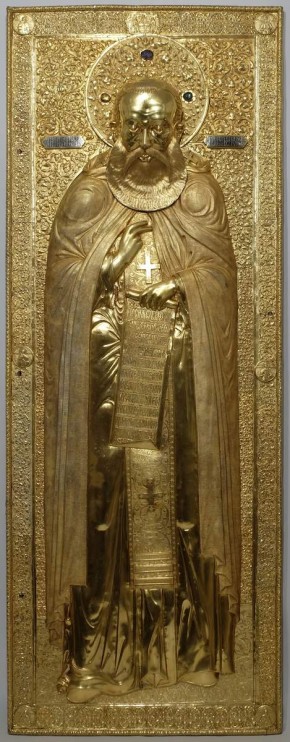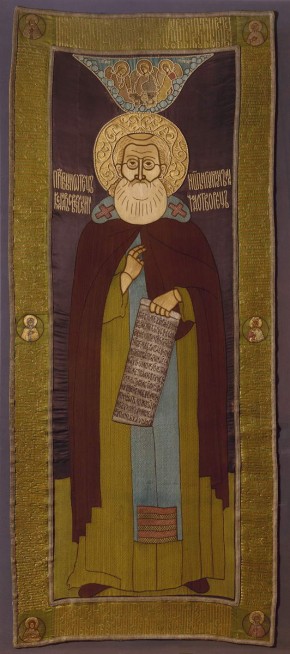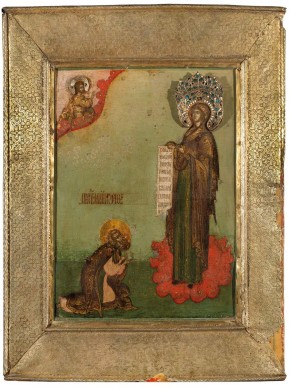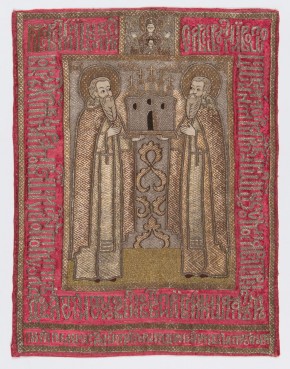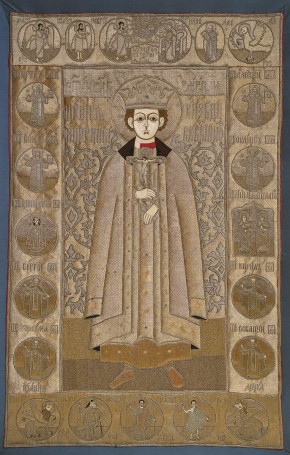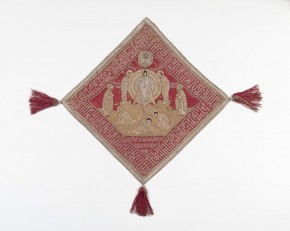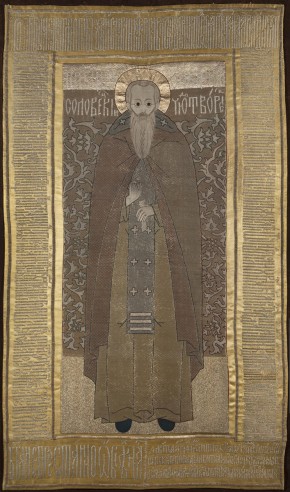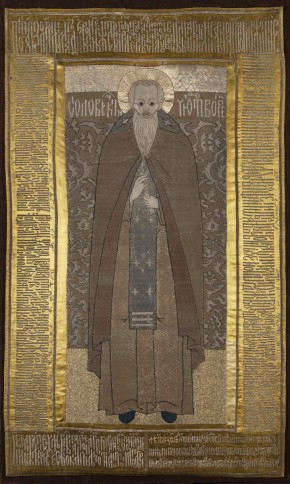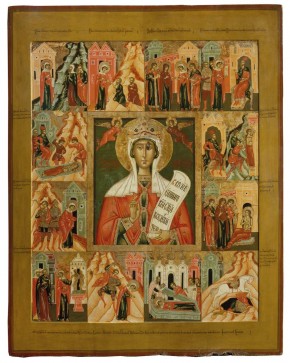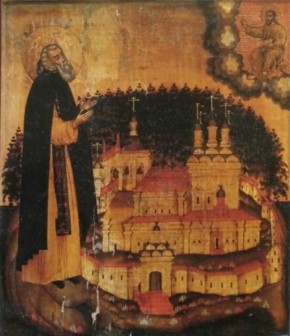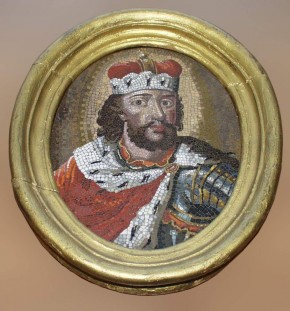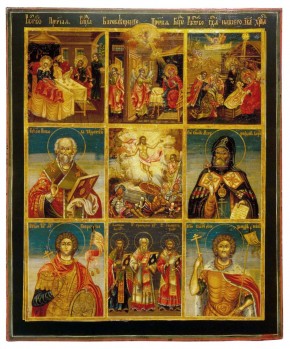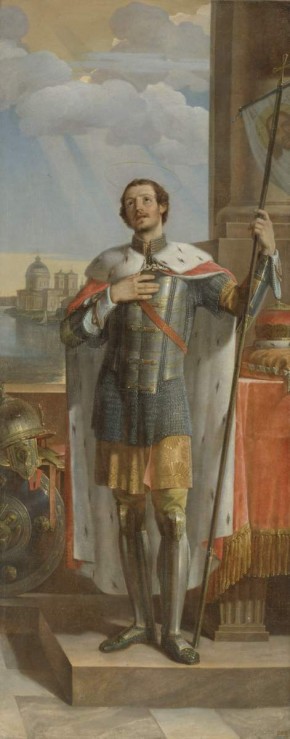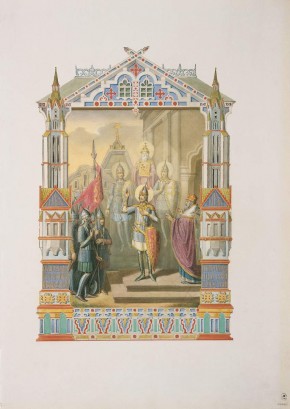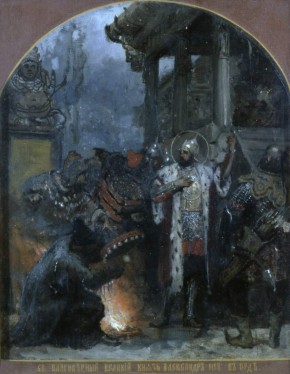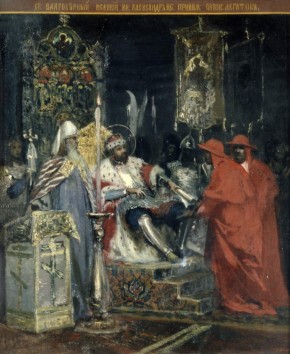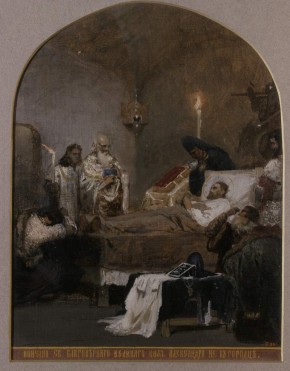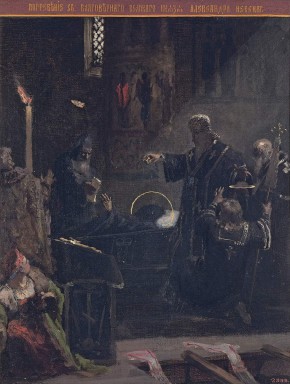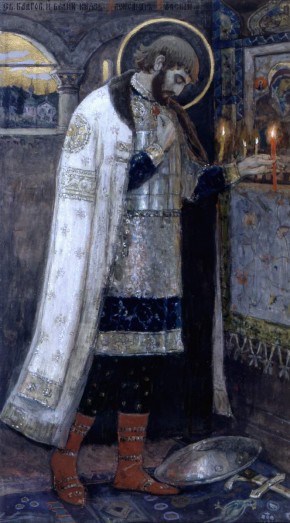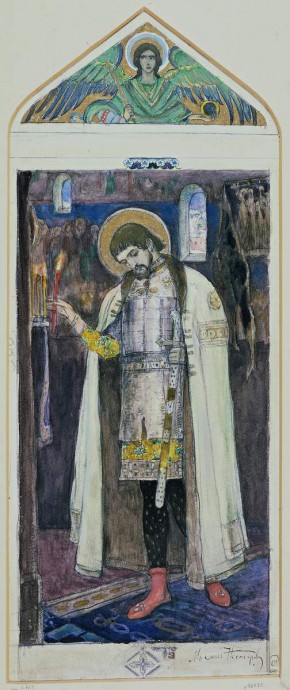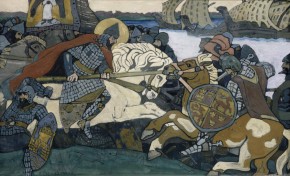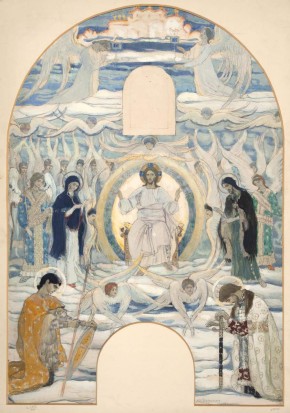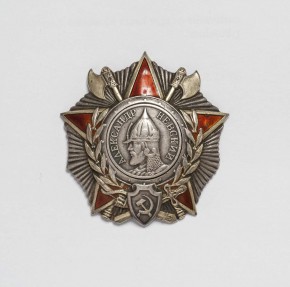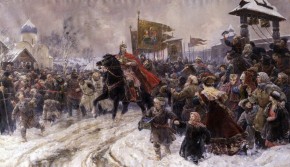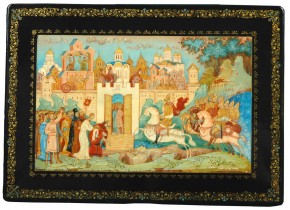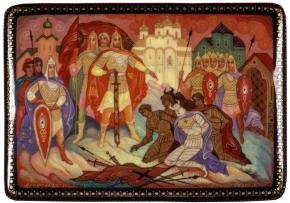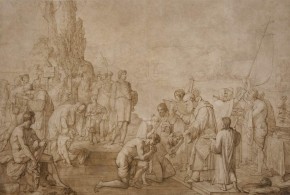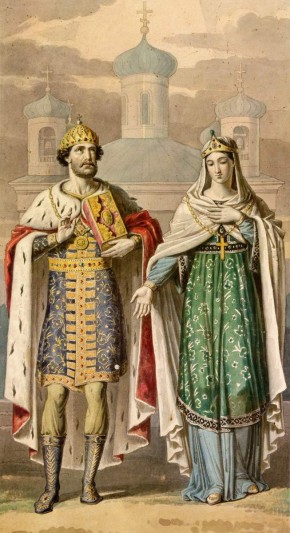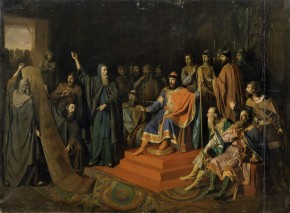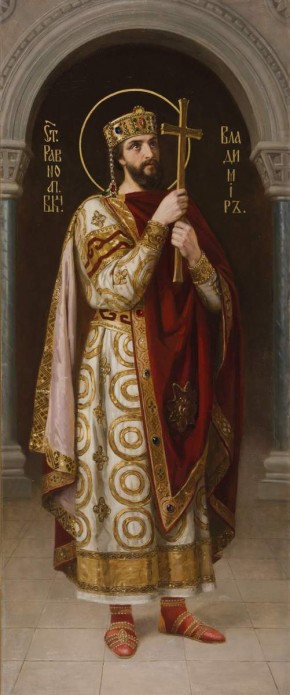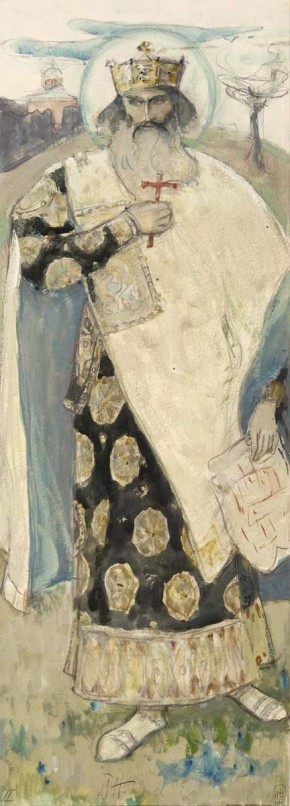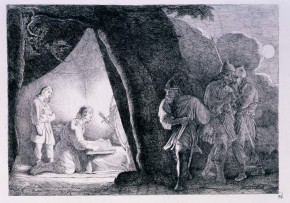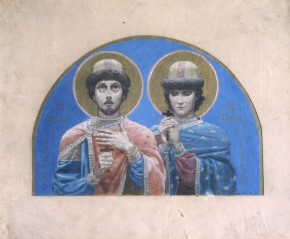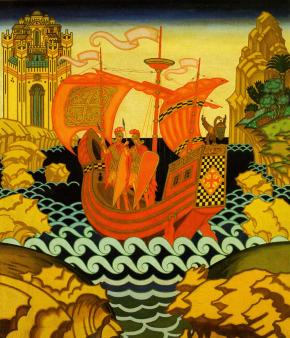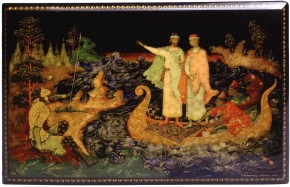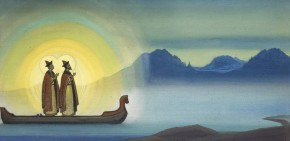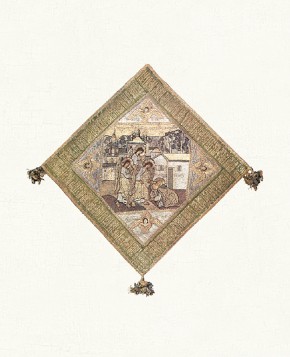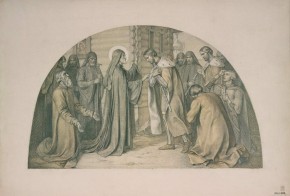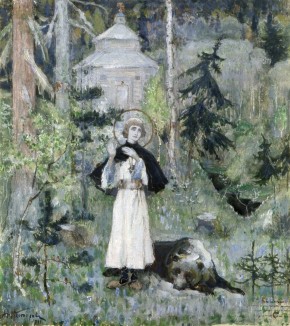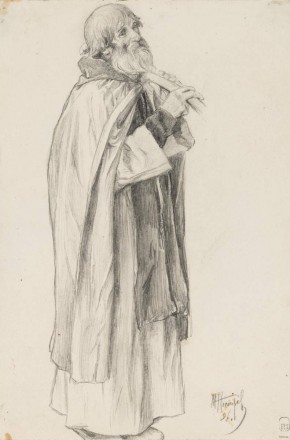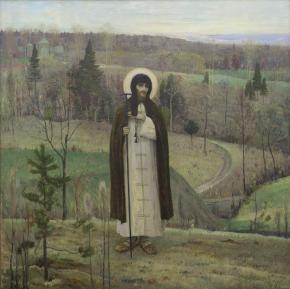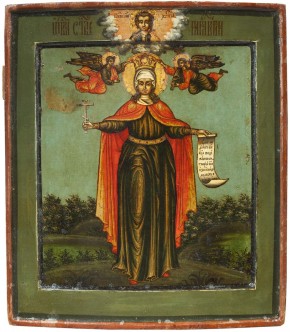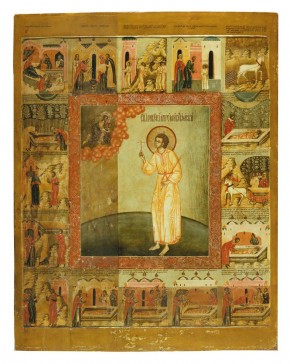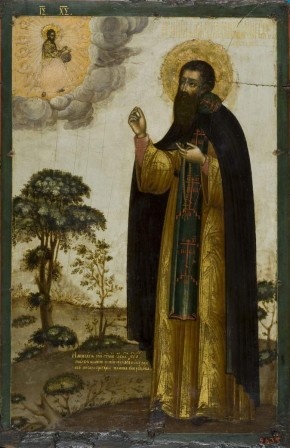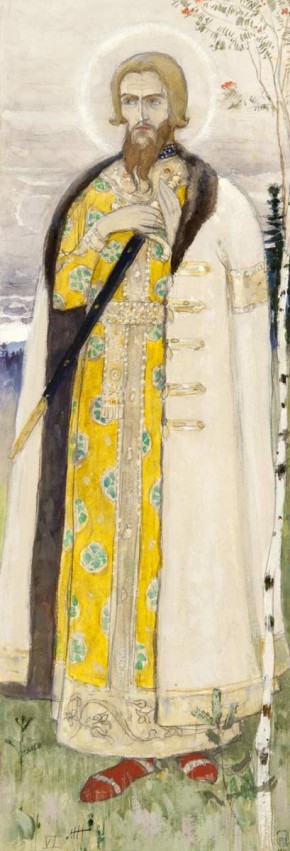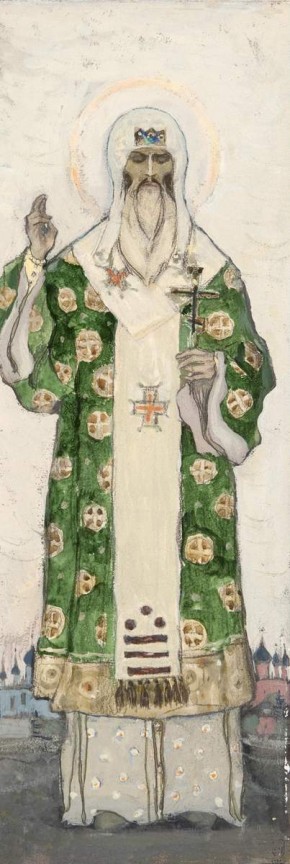Advanced search collections
St Boris and St Gleb
- Mid-14th century
- Wood, gesso, tempera. 142,5 x 94,3 x 2,5
- The State Russian Museum
- ДРЖ-2117
St Boris and St Gleb were the youngest of the twelve sons of Prince Vladimir of Kiev (978–1015). Boris ruled Rostov and Gleb ruled Murom.After Prince Vladimir’s death in 1015, their brother, Svyatopolk of Turov, seized the throne of Kiev for himself and had the brothers murdered. For his act of fratricide, Svyatopolk became known in Russia as «the cursed”. Boris and Gleb were known for their humility and Christian virtues.
For meekly accepting death and refusing to raise their hands against their brother, they were worshipped as «passion-bearers”. Symbolising Christian meekness in the face of internecine warfare and sibling rivalry, Boris and Gleb were regarded as the first Russian martyrs. Their humble acceptance of death was likened to Christ’s own sacrifice and death on the cross. In 1037, Jaroslav the Wise canonized the two brothers, who became the first Russian saints.
This particular icon depicts the two princes in royal robes, holding crosses and swords. The professional attributes of the work suggest that it was painted by a leading icon-painter in the fourteenth century. Russian Museum: From Icons to the Modern Times. Palace Editions, St Petersburg, 2015. P. 41.
St Cyril of Beloozero
- Pavoloka. 121,7 х 62 х 3
- The State Russian Museum
- ДРЖ-2733
Преподобный Кирилл Белозерский, с житием в двадцати одном клейме
- Wood, , , , pavoloka. 150,5 х 116,7
- The State Russian Museum
- ДРЖ-2741
Преподобный Сергий Радонежский, с житием в 12 клеймах
- Wood, , , tempera. 51 х 40,2 х 2,3
- The State Russian Museum
- ДРЖ-1195
Резная икона «Богоматерь на троне и Кирилл Белозерский»
- Wood, carving, , silver, chasing, engraving.
- The State Russian Museum
- БК-3467/а,б
Святые князья Борис и Глеб
- Wood, gesso, tempera. 116 х 82,5 х 2,5
- The State Russian Museum
- ДРЖ-3273
Святые царевич Дмитрий и князь Роман Углицкий
- Wood, , , pavoloka, tempera.
- The State Russian Museum
- ДРЖ-2053
Святитель Никита, архиепископ Новгородский
- Wood, , , , tempera, gilding. 31,6 × 26,8 × 2,5
- The State Russian Museum
- ДРЖ-2189
Избранные святые (преподобный Михаил Малеин, мученица Евдокия, великомученица Ирина, Алексий человек Божий, святой Иоанн Белгородский, праведная Анна и мученица Татьяна)
- 1636–1639
- Wood, , , pavoloka, gesso, tempera. 134 × 110 × 4
- The State Russian Museum
- ДРЖ-1814
Святые князья Феодор, Давид и Константин Ярославские
- Wood, , , , tempera, gilding. 27,3 × 24 × 2,7
- The State Russian Museum
- ДРЖ-2191
Крышка раки преподобного Александра Свирского
- 1643
- Silver, wood, emeralds, , , forging, chasing, casting, gilding. 214,5 × 80,7
- The State Russian Museum
- БК-2891
Покров "Преподобный Александр Свирский"
- 1643
- Damask, , , , pearls, weaving, stitching, stringing. 204 × 84,5
- The State Russian Museum
- ДРТ-263
Преподобный Иосиф Волоцкий в молении пред Богоматерью
- 1650s
- Wood, , , , pavoloka, gesso, tempera, , silver, carving, , . 40,7 × 31 × 3,1
- The State Russian Museum
- ДРЖ-269
Пелена. Зосима и Савватий Соловецкие
- 1650–1660
- Silk, , , . 40,5 х 30,5
- The State Russian Museum
- ДРТ-85
Пелена (плащаница) «Царевич Димитрий»
- 1656
- Taffeta, damask, , , .
- The State Russian Museum
- ДРТ-206
Палица. Преображение. Зосима и Савватий Соловецкие
- 1658
- Taffeta, canvas, , , , pearls. 44,2 × 43
- The State Russian Museum
- ДРТ-94
Савватий Соловецкий. Покров
- Silk, , , , .
- The State Russian Museum
- ДРТ-300
Зосима Соловецкий. Покров
- 1661
- Silk, , , , . 195 × 113
- The State Russian Museum
- ДРТ-301
Великомученица Параскева Пятница, с житием в 12 клеймах
- Wood, , , , pavoloka, gesso, tempera.
- The State Russian Museum
- ДРЖ-3038
Александр Свирский
- Wood, tempera, , .
- The State Russian Museum
- ДРЖ-907
Dionysius and Workshop
Dionysius
Circa 1440 - Before 1508
Old Russian painter of icons and frescoes. Headed a team of artists including two of his sons — Vladimir and Theodosius. Painted the frescoes and iconostasis of the Cathedral of the Dormition in the Moscow Kremlin (1481) and the Cathedral of the Nativity of the Blessed Virgin in the St Ferapont Monastery (1502-03). Created one of the recognised masterpieces of Old Russian icon-painting - The Crucifixion (1500).
Procopius Chirin
?, Novgorod — circa 1628, MoscowСтрогановская школа
ARMOURY CHAMBER, Moscow
Мастерская царицы Евдокии Лукьяновны Стрешневой, жены царя Михаила Федоровича
Мастерская Анны Ивановны Строгановой
Икона «Александр Невский»
- Mosaic.
- The State Russian Museum
- СТ-2
Воскресение Христово (девятичастная)
- Wood, mixed media, . 45,2 х 38 х 2,7
- The State Russian Museum
- ДРЖ Б-1406
Благоверный князь Александр Невский
- 1819
- Canvas, oil. 165 х 67
- The State Russian Museum
- Ж-3303
Александр Невский принимает благословение перед боем со шведами
- 1855
- Paper, watercolours, white pigment, gold. 46 х 34,6
- The State Russian Museum
- Р-46299
Александр Невский в Орде
- 1876
- Canvas mounted on cardboard, oil. 39 х 32
- The State Russian Museum
- Ж-5686
Александр Невский принимает папских легатов
- 1876
- Canvas mounted on cardboard, oil. 37,8 х 32,3
- The State Russian Museum
- Ж-1374
Кончина Александра Невского
- 1876
- Canvas mounted on cardboard, oil. 39 х 30
- The State Russian Museum
- Ж-1150
Погребение Александра Невского
- 1876
- Canvas mounted on cardboard, oil. 39 х 30
- The State Russian Museum
- Ж-1149
Благоверный князь Александр Невский, молящийся в храме Святой Софии перед Невской битвой
- 1894–1895
- paper mounted on cardboard, gouache, oil. 50 х 28,5
- The State Russian Museum
- Р-1595
Благоверный князь Александр Невский, молящийся перед Невской битвой в соборе Святой Софии Новгородской
- 1899
- Paper, gouache, watercolours, white pigment, bronze, graphite pencil.
- The State Russian Museum
- Р-40872
Кончина благоверного князя Александра Невского
- 1899–1900
- paper mounted on cardboard, graphite pencil, gouache, watercolours.
- The State Russian Museum
- Р-40897
Alexander Nevsky Striking Birger Jarl
- 1904
- Cardboard, gouache. 28 х 45
- The State Russian Museum
- Ж-1960
A Novgorod chronicle tells of a battle fought on the River Neva between Russian and Swedish forces in 1240. The purpose of the Swedish attack was to seize the mouth of the river and, consequently, an area of Russian territory. In the battle the Russian forces under Prince Alexander Yaroslavich of Novgorod defeated the enemy and their leader, Birger, the future King of Sweden. Prince Alexander Yaroslavich was granted the title “Nevsky” on account of his courage and military skill.
Христос во славе с предстоящими святыми Александром Невским и Георгием Победоносцем
- 1894
- Paper, gouache, watercolours, white pigment, graphite pencil.
- The State Russian Museum
- Р-40878
Орден Александра Невского
- 1942
- Silver, enamel.
- The State Russian Museum
- Мед.А-5294
Александр Невский
- 1944
- Porcelain, painting over glaze, gilding. 93 х 98 х 100
- The State Russian Museum
- СФ-340
Въезд Александра Невского во Псков после Ледового побоища
- 1945
- Canvas, oil. 288 x 492
- The State Russian Museum
- Ж-5618
Шкатулка „Въезд Александра Невского во Владимир“
- Papier-mâche, tempera, gold, varnish, painting.
- The State Russian Museum
- ОНИ/Р-3687
Alexander Nevsky. A Casket
- Kholuy, Ivanovo Region
- Papier-mâche, tempera, gold, varnish, painting.
- The State Russian Museum
- ОНИ/Р-4604
Alexander Yaroslavich (1221, Pereslavl-Zalessky – 1263, Gorodets) is a famous Russian commander. He was Prince of Novgorod in 1236-1240, 1241-1252, 1257-1259, Grand Prince of Kiev in 1249-1263 and Grand Prince of Vladimir in 1252-1263. He got the honourable sobriquet “Nevsky” as in 1240 he fought with great courage and won the Nevsky Battle (which occurred on the Neva River) against Swedish troops. On 5th April he defeated the German knights at Chudskoe Lake (“The Ice Battle”).
Ust-Ruditsa Factory of Mikhail Lomonosov
Vasily Shebuev
Солнцев Федор Григорьевич
Siemiradzki Henryk
1843, Pechenegi (Kharkiv Province) - 7902, Strzalkov (Poland)Painter, author of pictures on historical and religious subjects, portraitist, landscape painter. Studied physics and mathematics at the Kharkiv University (until 1864) and art at the Imperial Academy of Arts (1864-70; occasional student). Contributed to exhibitions at the Imperial Academy of Arts (from 1867). Fellow of the Imperial Academy of Arts in Germany and Italy (1871-77). Academician (1873), professor (1877). Awarded the Grand Prix at the World Exhibition in Paris and the Legion d\'\'hon-neur or The Luminaries of Christianity and La Femme ou la Coupe (1878). Councillor (1889) and full member of the Imperial Academy of Arts (1893). Member of the Academies of Arts of Berlin, Stockholm, Rome, Turin and Paris.
Nesterov Mikhail Vasilyevich
1862, Ufa - 1942, MoscowPainter, portraitist, landscape artist, genre painter, author of memoirs and essays on artists. Studied at the Moscow School of Painting, Sculpture and Architecture (1877-81, 1884-86) and the Imperial Academy of Arts (1881-84). Full member of the Imperial Academy of Arts (1910). Member of the Society of Travelling Art Exhibitions (1896) and founding member of the Union of Russian Artists (1903). Contributed to the exhibitions of the Society of Travelling Art Exhibitions (1889-1901), World of Art (1899-1901), 36 Artists (1901-03), Union of Russian Artists (1922, 1923), All-Russian Exhibition in Nizhny Novgorod (1896), Exposition Universelle in Paris (1900), International Exhibitions in Munich (1898,1909) and Rome (1911), Die erste russische Kunstausstellung in Berlin (1922) and the Exhibition of Russian Art in New York (1924). Honoured Artist of the RUSSIAN SOVIET FEDERATED SOCIALIST REPUBLIC (1942).
Roerich Nicholas (Nikolai Konstantinovich)
1874, St Petersburg - 7, Kullu (India)Painter, theatrical designer, writer. Studied under Arkhip Kuindzhi at the Imperial Academy of Arts (1893-97), Faculty of Law, St Petersburg University (1893-98) and Fernand Cormon\'\'s studio in Paris (1900-01). Academician of painting (1909). Contributed to exhibitions (from 1895). Contributed to the exhibitions of the World of Art (1902, 1903, 191 1-17; founding member 1910; chairman 1910-13), Union of Russian Artists ( 1903-10; member from 1903), Salon d\'\'Automne (1906, 1907; member from 1906), Exposition Universelle in Paris (1900), World Exhibition in St Louis (1904), International Exhibitions in Munich (1909), Rome (1911, 1914) and Malmo (1914) and the Exhibitions of Russian Art in Paris (1906-08), Berlin (1906) and Vienna (1908). Director of the School of Drawing, Society for the Encouragement of the Arts (1906-16). Designed for theatres in Moscow and St Petersburg and Sergei Diaghilev\'\'s Saisons Russes (from 1907). Emigrated (1918). Settled in Kullu in India (1928).
Орлов Сергей Михайлович
SEROV Vladimir Alexandrovich
1910, Emmaus, Tver Province — 1968, MoscowPainter, graphic artist, book and poster designer. Studied at the VKhUTEIN / Institute of Proletarian Fine Art / Ilya Repin Institute of Painting, Sculpture and Architecture (1927–1933) in Leningrad. Member of the Union of Artists (1932). Taught at the Ilya Repin Institute of Painting, Sculpture and Architecture (1933–1942). Designed posters for the Fighting Pencil group of artists (1941–1942). People’s Artist of the RSFSR (1956), People’s Artist of the USSR (1958). Corresponding member and academic secretary (1947), full member (1954), Vice President (from 1958), President (1962–1968) of the USSR Academy of Arts, corresponding member of the East German Academy of Arts (1963). Member of the Awarding Committee for the Lenin and State prizes (from 1960). Winner of the Stalin Prize (1948,1951). Awarded medals “For the Defence of Leningrad”, “For Valiant Labour in the Great Patriotic War 1941–1945”, “For the Victory Over Germany in the Great Patriotic War 1941–1945” (1944–1945), Order of Lenin (1957), gold medal from the USSR Ministry of Culture (1958), silver medal at the World Exhibition in Brussels (1958), Order of the Red Banner of Labour.
Мстера, Владимирская область
Sedov Vladimir
Холуй, Ивановская область
Крещение Российского народа при великом князе Владимире
- 1804
- Sepia, brush, nib. 55,9 х 82
- The State Russian Museum
- Р-5979
Святые Владимир и Ольга
- 1833
- Paper, watercolours. 59,2 х 43,9
- The State Russian Museum
- Р-35421
Крещение русского народа
- Paper, .
- The State Russian Museum
- Гр.-36044
Обращение князя Владимира в христианство
- 1866
- Canvas, oil. 170 х 230
- The State Russian Museum
- Ж-5634
Святой равноапостольный Владимир
- 1890s
- Canvas, oil. 148 х 62
- The State Russian Museum
- ЖБ-1301
Равноапостольный князь Владимир
- 1899–1900
- Paper, gouache, watercolours, white pigment, graphite pencil.
- The State Russian Museum
- Р-40874
Нотбек Александр (Иоганн-Вильгельм фон) Васильевич
Unknown painter
Заболотский Петр Петрович
Бодаревский Николай Корнильевич
St Boris and St Gleb
- Mid-14th century
- Wood, gesso, tempera. 142,5 x 94,3 x 2,5
- The State Russian Museum
- ДРЖ-2117
St Boris and St Gleb were the youngest of the twelve sons of Prince Vladimir of Kiev (978–1015). Boris ruled Rostov and Gleb ruled Murom.After Prince Vladimir’s death in 1015, their brother, Svyatopolk of Turov, seized the throne of Kiev for himself and had the brothers murdered. For his act of fratricide, Svyatopolk became known in Russia as «the cursed”. Boris and Gleb were known for their humility and Christian virtues.
For meekly accepting death and refusing to raise their hands against their brother, they were worshipped as «passion-bearers”. Symbolising Christian meekness in the face of internecine warfare and sibling rivalry, Boris and Gleb were regarded as the first Russian martyrs. Their humble acceptance of death was likened to Christ’s own sacrifice and death on the cross. In 1037, Jaroslav the Wise canonized the two brothers, who became the first Russian saints.
This particular icon depicts the two princes in royal robes, holding crosses and swords. The professional attributes of the work suggest that it was painted by a leading icon-painter in the fourteenth century. Russian Museum: From Icons to the Modern Times. Palace Editions, St Petersburg, 2015. P. 41.
Святые князья Борис и Глеб
- Wood, gesso, tempera. 116 х 82,5 х 2,5
- The State Russian Museum
- ДРЖ-3273
Убиение Бориса
- 1835–1838
- Paper, etching.
- The State Russian Museum
- Гр-12410
Князья Борис и Глеб
- 1896–1898
- Cardboard, oil. 31 х 38,8
- The State Russian Museum
- Ж-1825
Ship (Boris and Gleb Sailing)
- 1926
- Canvas, oil. 105,5 х 89
- The State Russian Museum
- Ж-9056
Пластина «Видение Бориса и Глеба воину Пельгусию»
- Papier-mâche, tempera, gold, varnish, painting.
- The State Russian Museum
- ОНИ/Р-3923
Boris and Gleb
- 1942
- Tempera, canvas. 61 х 123
- The State Russian Museum
- Ж-7089
St Boris and St Gleb were two sons of Grand Prince Vladimir, the ruler of Kievan Rus who accepted Christianity in 988. Following Christian teachings, Boris and Gleb would not go against their elder brother; they prevented his murder, and thereby strengthened the principles of Orthodoxy that had come to replace paganism with its harsh and savage customs. Because of their many good works the two brothers, who were murdered in 1015, were the first princes to be canonized by the Russian and Byzantine Churches.
Декоративный кубок «Борис и Глеб»
- 1990
- .
- The State Russian Museum
- Рк-455
Bruni Fidelio (Fyodor Antonovich)
1801, Milan -1875, St PetersburgPainter, engraver, author of religious and history compositions, portraitist. Son of the painter and sculptor Antonio Baroffi-Bruni. Moved to Russia with his father (1807). Studied under Alexei Yegorov, Andrei Ivanov and Vasily Shebuyev at the Imperial Academy of Arts (from 1809). Graduated with a first-class degree (1818). Moved to Rome to con¬tinue his art education (1819). Returned to Russia and painted portraits and icons for churches and cathedrals in St Petersburg and environs (1835-38). Lived and worked in Rome (1838-43, 1843-45). Honorary member of the Academies of Art of Bologna and Milan, professor of the Florentine Academy of Arts and St Luke\'\'s Academy in Rome. Taught at the Imperial Academy of Arts (1836-38, 1846-71). Second-class professor (1836), first-class professor (1846), rector of painting and sculpture (1855-71). Curator of the Imperial Hermitage picture gallery (1849-64), headed the mosaic studio at the Imperial Academy of Arts (from 1866
Ryabushkin Andrei Petrovich
1861, Stanichnaya (Tambov Province) - 1904, Divdino (Novgorod Province)Painter, graphic artist. Studied at the Moscow School of Painting, Sculpture and Architecture (1875-82) and the Imperial Academy of Arts (1882-90). Member of the Society of Artists of History Painting (from 1895), World of Art (from 1901) and the Union of Russian Artists (from 1903). Contributed to exhibitions at the Imperial Academy of Arts (from 1888).
Bilibin Ivan Yakovlevich
1876, Tarkhovka, St Petersburg Province — 1942, LeningradGraphic artist, theatrical designer. Studied at the Faculty of Law, St Petersburg University (1896–1900), School of Drawing, Society for the Encouragement of Arts (1895–1898), Anton Ažbè’s school in Munich (1898), under Ilya Repin at the Princess Maria Tenisheva School (1898–1900) and at the Higher School of Art, Imperial Academy of Arts (1900–1904). Contributed to exhibitions (from 1900). Founding member of the World of Art (1900–1917). Drew for World of Art, Hell’s Post, Bugbear and Golden Fleece and magazines. Designed for theatres (from 1907). Illustrated and designed children’s books — traditional heroic poems, folk tales and the fairytales of Alexander Pushkin — for publishing houses in St Petersburg (1900s). Illustrated the fairytales of Alexander Pushkin for Goslitizdat (1930s). Created his own highly original style of book design, based on the motifs of Russian folk and medieval art.
Палех, Ивановская область
Kholmogory
Крышка раки преподобного Александра Свирского
- 1643
- Silver, wood, emeralds, , , forging, chasing, casting, gilding. 214,5 × 80,7
- The State Russian Museum
- БК-2891
Покров "Преподобный Александр Свирский"
- 1643
- Damask, , , , pearls, weaving, stitching, stringing. 204 × 84,5
- The State Russian Museum
- ДРТ-263
Александр Свирский
- Wood, tempera, , .
- The State Russian Museum
- ДРЖ-907
Явление Троицы преподобному Александру Свирскому. Палица
- Stitching, , , spangles, passementerie, , spangle, .
- The State Russian Museum
- ДРТ-217
Пелена. Зосима и Савватий Соловецкие
- 1650–1660
- Silk, , , . 40,5 х 30,5
- The State Russian Museum
- ДРТ-85
Палица. Преображение. Зосима и Савватий Соловецкие
- 1658
- Taffeta, canvas, , , , pearls. 44,2 × 43
- The State Russian Museum
- ДРТ-94
Савватий Соловецкий. Покров
- Silk, , , , .
- The State Russian Museum
- ДРТ-300
Зосима Соловецкий. Покров
- 1661
- Silk, , , , . 195 × 113
- The State Russian Museum
- ДРТ-301
St Cyril of Beloozero
- Pavoloka. 121,7 х 62 х 3
- The State Russian Museum
- ДРЖ-2733
Преподобный Кирилл Белозерский, с житием в двадцати одном клейме
- Wood, , , , pavoloka. 150,5 х 116,7
- The State Russian Museum
- ДРЖ-2741
Резная икона «Богоматерь на троне и Кирилл Белозерский»
- Wood, carving, , silver, chasing, engraving.
- The State Russian Museum
- БК-3467/а,б
Преподобный Сергий Радонежский, с житием в 12 клеймах
- Wood, , , tempera. 51 х 40,2 х 2,3
- The State Russian Museum
- ДРЖ-1195
Сергий Радонежский благословляет Дмитрия Донского на побоище и с ним отпускает двух иноков Ослябю и Пересвета
- 1840s
- Paper, graphite pencil, sepia. 29,8 х 43,8
- The State Russian Museum
- Р-916
Юность преподобного Сергия
- 1891
- paper mounted on cardboard, watercolours, gouache, bronze paint, graphite pencil. 27,3 х 24,2
- The State Russian Museum
- Р-6188
Труды Сергия Радонежского
- 1896
- Paper, graphite pencil. 25 x 16,7
- The State Russian Museum
- Р-1586
Venerable Sergius of Radonezh
- 1899
- Canvas, oil. 248 х 248
- The State Russian Museum
- Ж-1848
M.V. Nesterov believed that the salvation of Russia lied in a moral ideal. For the artist the embodiment of such an ideal of Venerable Sergius of Radonezh, the founder of the Trinity Lavra of St. Sergius, a hermit, a wonder-worker, a patron saint of all Russian lands. The image of Sergius of Radonezh attracted the artist’s attention during his whole life. Nesterov studied his deeds in chronicles and annals, and the results of these studies were 15 major paintings dedicated to the “hegumen of all Russia”. Among them there are Vision to Young Varfolomey and Youth of Venerable Sergius created in 1892—1897; a triptych Deeds of Venerable Sergius dated back to 1896—1897; Venerable Sergius 1899; studies for the work Venerable Sergius Bids Farewell to Dmitry Donskoy created in 1898—1899 and many others. The painter himself wrote about his favourite character: “I painted the life of a good Russian man of the 14th century, a man who sensed Nature and its beauty, and a man who loved his motherland and strived for truth. I illustrated a legend that my people made long ago about a person who was worth their love and memory”.
Преподобный Сергий Радонежский
- 1899-1900
- Paper, gouache, watercolours, white pigment, graphite pencil.
- The State Russian Museum
- Р-40881
Завьялов Федор Семенович
St Cyril of Beloozero
- Pavoloka. 121,7 х 62 х 3
- The State Russian Museum
- ДРЖ-2733
Преподобный Кирилл Белозерский, с житием в двадцати одном клейме
- Wood, , , , pavoloka. 150,5 х 116,7
- The State Russian Museum
- ДРЖ-2741
Резная икона «Богоматерь на троне и Кирилл Белозерский»
- Wood, carving, , silver, chasing, engraving.
- The State Russian Museum
- БК-3467/а,б
Крышка раки преподобного Александра Свирского
- 1643
- Silver, wood, emeralds, , , forging, chasing, casting, gilding. 214,5 × 80,7
- The State Russian Museum
- БК-2891
Покров "Преподобный Александр Свирский"
- 1643
- Damask, , , , pearls, weaving, stitching, stringing. 204 × 84,5
- The State Russian Museum
- ДРТ-263
Пелена. Зосима и Савватий Соловецкие
- 1650–1660
- Silk, , , . 40,5 х 30,5
- The State Russian Museum
- ДРТ-85
Палица. Преображение. Зосима и Савватий Соловецкие
- 1658
- Taffeta, canvas, , , , pearls. 44,2 × 43
- The State Russian Museum
- ДРТ-94
Савватий Соловецкий. Покров
- Silk, , , , .
- The State Russian Museum
- ДРТ-300
Зосима Соловецкий. Покров
- 1661
- Silk, , , , . 195 × 113
- The State Russian Museum
- ДРТ-301
Великомученица Параскева Пятница, с житием в 12 клеймах
- Wood, , , , pavoloka, gesso, tempera.
- The State Russian Museum
- ДРЖ-3038
Александр Свирский
- Wood, tempera, , .
- The State Russian Museum
- ДРЖ-907
Параскева Пятница
- Wood, gesso, tempera.
- The State Russian Museum
- ДРЖ-2321
Святой Артемий Веркольский, с житием в 16 клеймах
- Wood, , , pavoloka, , tempera.
- The State Russian Museum
- ДРЖ-3126
Явление Троицы преподобному Александру Свирскому. Палица
- Stitching, , , spangles, passementerie, , spangle, .
- The State Russian Museum
- ДРТ-217
Святитель Никита, архиепископ Новгородский
- Wood, , , , tempera, gilding. 31,6 × 26,8 × 2,5
- The State Russian Museum
- ДРЖ-2189
Преподобный Варлаам Хутынский
- Wood, , gesso, pavoloka, tempera.
- The State Russian Museum
- ДРЖ-1168
